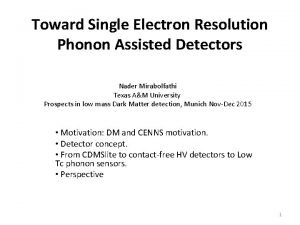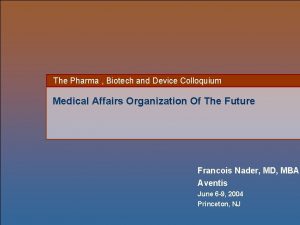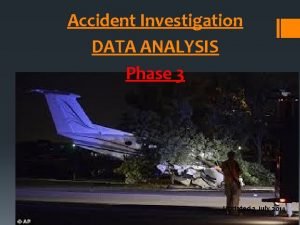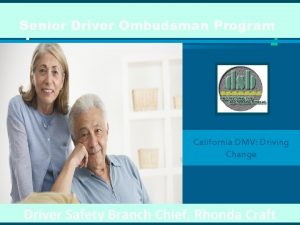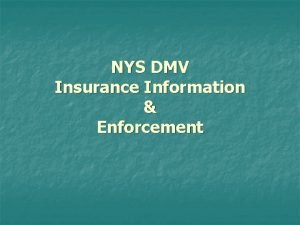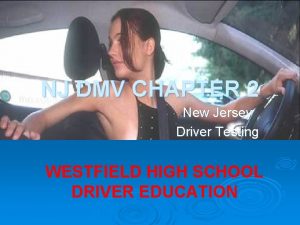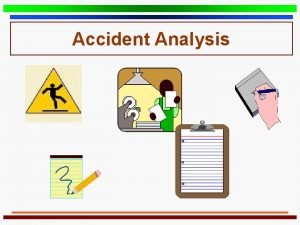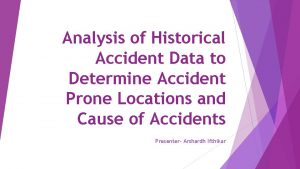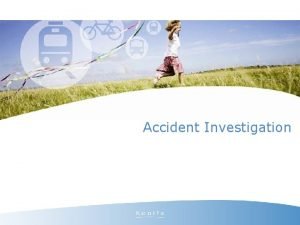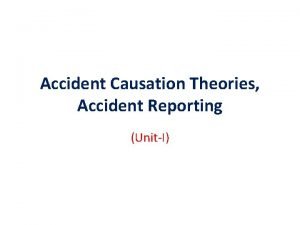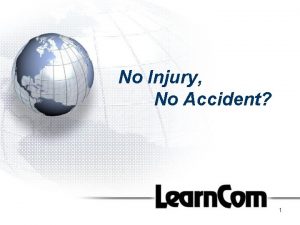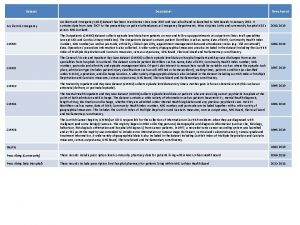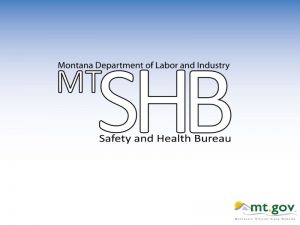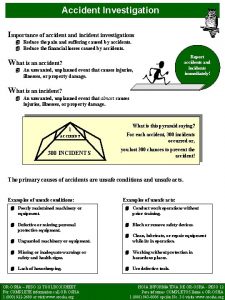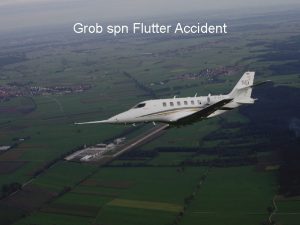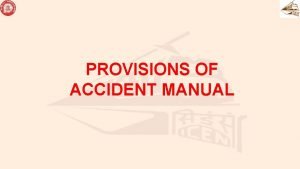AV Accident Analysis from CA DMV Nazanin Nader



















- Slides: 19

AV Accident Analysis from CA DMV Nazanin Nader – Industrial and Systems Engineering T 3 e Webinar – Talking Technology and Transportation in Education

Autonomous Vehicles and Level Definition Reproduced AS-IS with permission from SAE-International J 3016 TM T 3 e Webinar – Talking Technology and Transportation in Education 2

Autonomous Vehicles and Level Definition Reproduced AS-IS with permission from SAE-International J 3016 TM T 3 e Webinar – Talking Technology and Transportation in Education 3

Where are we now? Why is it important? T 3 e Webinar – Talking Technology and Transportation in Education 4

Where are we now? Why is it important? The human driver is responsible for monitoring the safe operation of the vehicle at all times, and must be capable of taking over immediate control in the event of an autonomous technology failure or other emergency CA DMV “Autonomous Vehicles Deployment Regulation” T 3 e Webinar – Talking Technology and Transportation in Education 5

Accidents’ Reporters Overview • 37 manufacturers have permits to test on public roads (growing list) • 5 of them reported accidents (collisions and/or injuries involved) up to July '17 T 3 e Webinar – Talking Technology and Transportation in Education 6

Accidents’ Reporters Overview • 37 manufacturers have permits to test on public roads (growing list) • 5 of them reported accidents (collisions and/or injuries involved) up to July '17 Cruise Delphi Automatio 4% n 4% GM Cruise 4% Nissan 4% Google 84% 26 accidents up to July 2017 T 3 e Webinar – Talking Technology and Transportation in Education 7

Accidents’ Reporters Overview • 37 manufacturers have permits to test on public roads (growing list) • 5 of them reported accidents (collisions and/or injuries involved) up to July '17 Cruise Delphi Automatio 4% n 4% GM Cruise 4% Nissan 4% Autonomous miles driven 25000 19787. 3 20000 14945. 84 15000 10015. 21 10000 5584. 4 5000 683 1918. 1 2412. 5 590 550 en w ag s Vo l ks ot or M sl Te er c a sed e N Reporter M Google 84% Be nz sa n is rd Fo ph i el ru i G M C D se h Bo sc BM W 0 26 accidents up to July 2017 T 3 e Webinar – Talking Technology and Transportation in Education 8

Accidents’ Reporters Overview • 37 manufacturers have permits to test on public roads (growing list) • 5 of them reported accidents (collisions and/or injuries involved) up to July '17 Cruise Delphi Automatio 4% n 4% 1, 060, 199 GM Cruise 4% Nissan 4% Autonomous miles driven 25000 19787. 3 20000 14945. 84 15000 10015. 21 10000 5584. 4 5000 683 1918. 1 2412. 5 590 550 en w ag s Vo l ks ot or M sl Te er c a sed e N Reporter M Google 84% Be nz sa n is rd Fo ph i el ru i G M C D se h Bo sc BM W 0 e gl o Go 26 accidents up to July 2017 T 3 e Webinar – Talking Technology and Transportation in Education 9

Accident Overview T 3 e Webinar – Talking Technology and Transportation in Education 10

Accident Overview 7 9 24 T 3 e Webinar – Talking Technology and Transportation in Education 11

Detection of Rear-End Collisions • 62% of accidents are low speed rear-end collisions with the AV in front • Conventional vehicles 30% of the accidents are rear-end Vehicle #1 (AV) 15% Rear Damag e 23% 62% Side Damag e Vehicle #2 (Conventional) 12% 4% 12% 27% 45% T 3 e Webinar – Talking Technology and Transportation in Education Rear Damage Side Damage Front Damage No Damage N/A 12

Detection of Rear-End Collisions • 62% of accidents are low speed rear-end collisions with the AV in front • Conventional vehicles 30% of the accidents are rear-end Vehicle #1 (AV) 15% Rear Damag e 23% 62% Side Damag e Vehicle #2 (Conventional) 12% 4% 12% 27% 45% Rear Damage Side Damage Front Damage No Damage N/A • An AV in the rear will deploy automatic breaking to avoid a rear-end collision • Can an AV in the front detect a collision? T 3 e Webinar – Talking Technology and Transportation in Education 13

Detection of Rear-End Collisions • 62% of accidents are low speed rear-end collisions with the AV in front • Conventional vehicles 30% of the accidents are rear-end Vehicle #1 (AV) 15% Vehicle #2 (Conventional) Rear Damag e 23% 62% Side Damag e 12% Manual disengagement before collision Manual disengagement after collision Autonomous disengagement 12% 27% 45% Rear Damage Side Damage Front Damage No Damage N/A • An AV in the rear will deploy automatic breaking to avoid a rear-end collision 15% Conventional mode 4% 19% • Can an AV in the front detect a collision? Autonomous mode 62% 4% T 3 e Webinar – Talking Technology and Transportation in Education 14

Vehicle Make and Appearance • Are rear-end collisions a problem of conventional drivers’ reaction to AVs? Chevrolet Audi Nissan Google Prototype Retrofitted Lexus 0 2 4 6 8 10 12 T 3 e Webinar – Talking Technology and Transportation in Education 15

Vehicle Make and Appearance • Are rear-end collisions a problem of conventional drivers’ reaction to AVs? 1. 2 e-4 Chevrolet 5 e-5 Audi 2. 8 e-4 Nissan 2. 4 e-5 Google Prototype 1. 8 e-5 Retrofitted Lexus 0 Type of Vehicle 2 4 6 8 10 12 Total number of Accidents Total Miles Travelled Accident Frequency Google Prototype 10 403, 226 2. 4 e-5 Retrofitted Lexus 12 649, 841 1. 8 e-5 T 3 e Webinar – Talking Technology and Transportation in Education 16

Correlation with Mileage Driven 30 • The plot shows that accidents are still happening normal trend for conventional vehicles, but is this going to change as AV technology is further developed? Correlation between cumulative accidents and cumulative autonomous miles 25 Cumulative Accidents 20 • Gaps and stationary trends are expected in the future as fewer accidents are witnesses (but mileage travelled keeps increasing) 15 10 5 0 0 200000 400000 600000 800000 1000000 1200000 • This is due to the technology involved: AV “brains” use Machine Learning: as the algorithms are tuned and learn to handle more scenarios we expect a lower number of accidents Cumulative autonomous miles [miles] T 3 e Webinar – Talking Technology and Transportation in Education 17

Accidents Trends after July 2017 • The second half of 2017 saw 28 reported accidents of AVs • 50% of those are rear-end accidents, confirming this is the current problem to tackle • The majority of the accidents for the second half of 2017 are reported by GM, with Google having moved the majority of its testing to other States. rear-end breakdown T 3 e Webinar – Talking Technology and Transportation in Education 18

Preliminary Conclusions - 1 • We analyzed accident that occurred on public CA roads • Semi- Autonomous vehicles require the collaboration of human drivers HMI • Our analysis shows preliminary issues that need to be addressed in the HMI realm: 1. Predominance of rear-end accidents 2. Problems of detecting rear-end accidents by both driver and AV 3. No demonstrated merit to the claim that people purposefully collide with AVs 4. No demonstrated merit to the claim that anthropomorphous vehicles will have a lower frequency of collisions, i. e. , be safer T 3 e Webinar – Talking Technology and Transportation in Education 19
 Nazanin makkinejad
Nazanin makkinejad Nazanin khazra
Nazanin khazra Anakin-me
Anakin-me Nader sharifi
Nader sharifi Nader alaridah
Nader alaridah Nader pin extrication
Nader pin extrication Enes bin mâlik zayed bin malek
Enes bin mâlik zayed bin malek Assis prof
Assis prof Nader alaridah
Nader alaridah Nader mirabolfathi
Nader mirabolfathi Narrative review vs systematic review
Narrative review vs systematic review Francois nader
Francois nader Nader ahmadi
Nader ahmadi Amjad nader
Amjad nader Accident investigation data analysis
Accident investigation data analysis Dmv triangle
Dmv triangle Dmv ombudsman
Dmv ombudsman Dmv iies
Dmv iies Nj dmv 6 points of identification
Nj dmv 6 points of identification Nc license and theft bureau locations
Nc license and theft bureau locations









